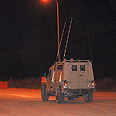
Trees for shields in Gaza vicinity area
To counter anti-tank missiles acquired by Gaza terrorist groups, IDF working to update defense systems, plants trees to block terrorist cells' views
The IDF has received a painful reminder of the growing threat posed by advanced rocket launchers in the hands of Gaza terror groups in the wake of Saturday's border attack which saw four IDF soldiers injured by an anti-tank missile fired from Gaza.
Related Stories
![]() Gaza: Anti-tank missile hits IDF jeep; 4 soldiers injured
Gaza: Anti-tank missile hits IDF jeep; 4 soldiers injured
![]() IDF soldier lightly injured in Gaza tunnel blast
IDF soldier lightly injured in Gaza tunnel blast
![]() Wounded IDF officer: I won't give up
Wounded IDF officer: I won't give up
The majority of the rockets, which have reached the hands of Hamas and the Islamic Jihad, were smuggled in from Iran, and have a range of up to 5 kilometers, putting large parts of Route 232 (the main road surrounding the Gaza perimeter) at risk.
A new threat
Those facing the biggest threat are farming vehicles, which work the land between the road and the border, as well as IDF vehicles patrolling the area.
Over the past two years and particularly since the April 2011 anti-tank missile attack on a Nahal-Oz school bus which claimed the life of Daniel Viflic, security regulations for army vehicles patrolling the route have become much stricter.
According to the new directives, driving along the border should be undertaken only when absolutely necessary and mostly with heavily armored vehicles, such as the D9 bulldozer and the Merkava Mark IV tanks with the recently installed "Windbreaker" active protection defense system.
The IDF's GOC Army Headquarters (Mazi) is developing a similar, yet smaller and cheaper, version of the "Windbreaker" which will be installed into patrol vehicles such as the Hummer and the Wolf armored vehicle.
The goal is to equip these vehicles with a system that would inform the soldiers inside that an anti-tank missile has been fired in their direction, thus giving them sufficient time to exit the vehicle.
The greens go green
Another solution utilizes tall trees to block terrorists' view. The trees are planted along Route 232, specifically in areas in range of the anti-tank missiles.
The goal of the trees is to intensively minimize terrorist cells' observational and aiming capabilities, in junctions or sharp turns where vehicles are forced to slow down. The project has only recently been launched and is slated to cover additional kilometers along the road.
Bibi's word
Prime Minister Netanyahu promised last month to fortify every house within a 4.5-7 km radius of Gaza, but the project has yet to be budgeted.
It is estimated to cost NIS 270 million (roughly $70 million), but its implementation has been marred by inter-governmental bickering over the funding source.
The government's decision to accept the prime minister's plan was in principle aloe, with the budgetary element postponed to a later date. Even with the beginning of the planning and tender process, it is estimated that full implementation could take up to two years.
In addition it should be noted that the project has been recommended to the government by the defense establishment for almost two years.
- Receive Ynetnews updates directly to your desktop










